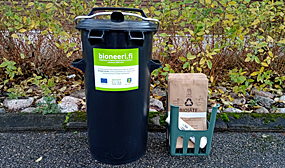
© Salpakierto
Salpakierto Oy provides municipal waste management services, such as waste collection and treatment, in the Lahti region in accordance with the Waste Act. In autumn 2020, a pilot project for the collection of biowaste was launched in Lahti with a derogation.
"Based on customer surveys, many families feel that the collection of biowaste is unnecessary because the amounts of waste in 240-litre containers seem so small," says Jani Vehviläinen, Development and Procurement Coordinator at Salpakierto. They wanted to experiment the separate collection with smaller containers and lighter transport vehicles.
For over a year now, volunteer smaller customers have been collecting their biowaste in 35 or 50-litre bins, depending on the size of their family. As usual, these are emptied every two weeks, but with a van, not a big truck. “Waste from around seven of the smaller customers is transported to the large 240-litre bins of the Biolinkki smallholders to await the actual truck.
The new service model provides all 195 smaller customers and 31 Biolinkki customers with a collection service, an outdoor bin with a protective bag, an indoor bin and paper biowaste bags. Those acting as Biolinkki link customers, the new service model also offers another major bonus: a lower collection fee than for small bin customers. "Without Biolinkki customers, the experiment would not be possible, which is why it was such a pleasant surprise to us that 40 per cent of the volunteers were willing to act as Biolinkki," says Vehviläinen.
Only 14% of mixed waste is biowaste
One of the aims of the experiment was to reduce the amount of biowaste ending in the mixed and energy waste stream. In a composition study before the experiment, around 61% of the mixed waste was biowaste. "The share of biowaste dropped to 28% in 4–5 months and to 14% within a year," says Linda Karlström, Project Engineer at Salpakierto. Even then, the sorting was done very carefully, as most of the biowaste was biowaste left inside the packaging.
An important issue for the participants in the experiment was that 66% were able to extend the discharge interval of their mixed waste and thus reduce the waste costs. "At the beginning of the experiment, more than half of the residents emptied their mixed waste every two weeks, but by the end of the trial, only 16% had a short collection interval."
The experiment brought other benefits to residential areas. There are now fewer large waste trucks on the road, reducing carbon emissions and noise pollution in urban areas. "Vans also have lower investment costs than waste collection trucks and are more readily available as electric vehicles," adds Karlström. This promotes healthy competition in waste transport.
Almost everyone wants to continue with the new model
Participants in the pilot have had the opportunity to respond to a customer satisfaction survey throughout the year. The results are overwhelmingly unanimous. "Residents have found the new service concept and its communication to be working well, and have been satisfied with both the bins and their emptying," says Karlström. Many people are surprised at the amount of biowaste that ends up being generated. "In addition, about 54% have been able to improve the sorting of other waste fractions."
More than 98% of those who took part in the pilot want to continue collecting biowaste under the new model, and Salpakierto has therefore decided to continue the pilot until the end of 2021. After that, the experiment will be continued with a new exemption until 2024 and it will be decided whether the new service model will remain permanent.
"The follow-up project is an important further research opportunity for us, and we will be looking at issues such as ergonomics at work," says Vehviläinen. Even small bins can weigh a lot if the family size is more than four people. "It's not a good idea to move the heaviest waste containers into the van by hand."
According to Vehviläinen, it is important to start experimenting with new ideas because it provides comparable data on, for example, the accumulation of biowaste. "We too have been able to weigh small waste containers about once a month during collection, which provides information for evaluation calculations both for us and for other waste management companies."
Read more
More information
- Development and Procurement Coordinator Jani Vehviläinen, Salpakierto Oy, firstname.lastname@salpakierto.fi
- Project Engineer Linda Karlström, Salpakierto Oy, firstname.lastname@salpakierto.fi